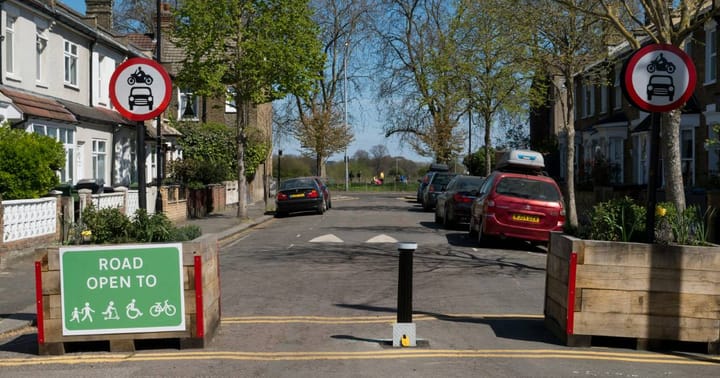How much is road tax?
The UK’s road-tax system uses several criteria to determine how much you have to pay; RHD explains them all while staving off sleep

As with all taxation systems, road tax is dull, complicated and undesirable – unless you’re a tax attorney or accountant, in which case I can see how there could be a certain artistry in understanding how different taxes interact, and how individuals and organisations can reduce their liabilities.
But for most of us road tax is just another unwelcome bill, except rather than having a nice meal in a restaurant, you don’t get to directly enjoy the results of your expenditure.
Pedants may insist on calling road tax by its official name of ‘vehicle excise duty’, but while on a certain level that urge is understandable, most people use the phrase ‘road tax’ as it’s more relevant, catchier and shorter; VED purists can go hang out with the people who enjoy pointing out that Big Ben is the name of the bell.
Aside from nomenclature, the other problem with the UK’s road-tax system is that it’s not one system but three discrete systems, each of which applies to cars that were new at certain points in time – 'first registered'– . Oh yes, and road tax rates increase every financial year, so this page will be out of date in 12 months, and I may forget to update it (cf: road tax is dull).
If that’s not enough, the current road-tax system for cars actually comprises two separate systems: one for the first year of a car’s life, and the other for the rest of it. Not to mention the fact there's a time-bound taxation supplement that expires after a certain number of years.
Let’s dive in – bring coffee.
Current road tax system
The road-tax system that is active at present has been in place since 1 April 2017 and comprises two main parts.
One applies only to the first year of a new car’s life and is based on how much carbon dioxide it emits. This is bundled into a new car’s ‘on-the-road’ price, so is organised by new-car salespeople and factored into deposits etc. The first-year rate ranges from £0 for cars emitting zero grams per kilometre of carbon dioxide (IE EVs) to £2,745 for cars that emit over 255g/km of CO2 (typically vehicles with large, powerful petrol engines).
There’s a handy table on the Gov website, which I’ll reproduce at the bottom of this article so as to no break up its flow, but to give you an idea most cars will be in the £260 to £670 ballpark for the first year.
The other road-tax rate is the one a car will attract for the rest of its life. This is a flat £190 for all cars – though this number will increase with inflation on 1 of April each year – for example prior to April 2024 it was £180.
There’s a paltry £10 discount on hybrids (including ‘mild’, conventional and plug-ins), which must cumulatively cost the Treasury dearly, but is barely a drop in the ocean given how much drivers are stung elsewhere. Hardly surprising this sop is soon to be dropped (see next subheading).

The other thing to know about the current road-tax regime is what is sometimes known as the 'expensive/luxury car supplement'. This applies to all vehicles costing £40,000 and more from new, including options, and sees new cars levied with an additional annual charge of £410, for six years.
Given you can specify a VW Golf up to £40k without too much difficulty, the ‘expensive’ and 'luxury' prefixes tends not to be used these days, but regardless of what you call it, the £410 supplement kicks in after the first CO2-based year (the one the dealer will organise), and runs to the sixth year of a car’s life. This brings the total annual tax bill for cars that cost £40,000 and more when they left the showroom to £600 (at present), and it carries over regardless of whether the car is sold, so bear it in mind if looking at second-hand vehicles.
Speaking of which, popular online classified advertisement platforms will tell you how much a specific car is to tax – just click/tap ‘running costs’ to see this.
You can pay for road tax annually, set up a monthly Direct Debit, or pay for six months’ worth at a time – though if you pay by DD you’ll be charged a total of £199.50 annually instead of £190, while if you pay for six months at a time you’ll pay the equivalent to £198 for a year. Yay.
Electric car road tax and hybrid car road tax 2025
Electric cars emit no CO2 directly so they’re currently exempt from all road tax – IE the first-year rate, the flat annual rate and the ‘luxury’ supplement.
This exemption ends on 1 April 2025 when EV owners will pay £10 for the first year of tax, and the same £190 flat annual rate all other vehicles are liable for, as well as the £410 ‘expensive’ five-year supplement if the EV costs £40k or more.
The £410 supplement won't apply retroactively to EVs currently on the road – it only applies to brand-new electric cars registered from 1 April 2025 - but existing EVs will be subject to the standard £190 annual rate. The daft £10 discount for hybrids will end on 1 April 2025, too.
That’s all assuming your EV was first registered after 1 April 2017. If it was registered prior to this (specifically between 1 March 2001 and 30 March 2017) you’ll only pay £20 a year.
Do note these numbers will change, at least with inflation, at the next Budget, when I might pop back to seamlessly update this page.
Road tax for cars first registered between 1 March 2001 and 31 March 2017
As if this weren’t involved enough already, if your car was first registered between the dates set out in bold above, you’ll pay an annual road tax rate that’s based on the vehicle’s CO2 emissions. As before, you can find a table for this at the bottom of this article.

Long and short: you’ll pay £0 if a car from these dates emits under 100g/km of CO2, up to £735 if it emits over 255g/km. Most cars are £190 to £305 a year – though manufactures capitalised on the tax exemption for sub 100g/km cars, meaning there are a lot of 1.6-litre diesels knocking about that are exempt from road tax (for now) – though most of these will fall foul of ULEZ rules, and other emission-zone frolics, so be careful. The Goldilocks car is 2016 diesel that emits 100g/km of CO2 or less, which should be both ULEZ compliant, and exempt from road tax.
That £0 band annual disappears on 1 April 2025, at which point cars that previously occupied it (EG sub 100g/km diesels) will be bumped up to the next band, which is at present £20, but which will almost certainly increase by whatever approximation of inflation the Treasury deems fit; the Gov site says the £20 band is “subject to change” – so who knows what it’ll be next year.
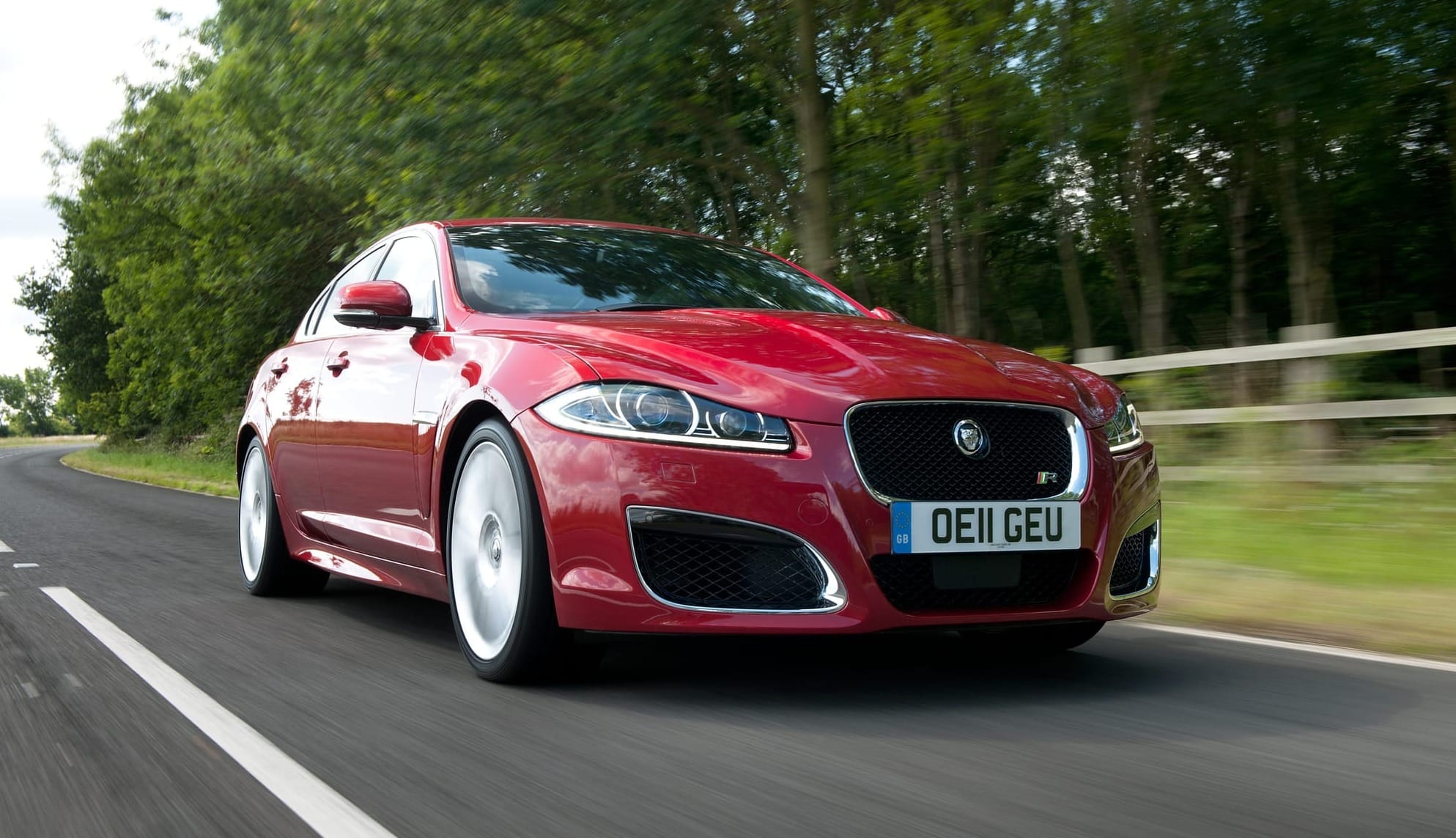
Cars registered prior to 1 March 2001
This won’t apply to most people as few of us drive cars made prior to spring ‘01, but if you’re one of these aficionados the road tax system is based on engine size, and nothing else.
Cars with an engine not over 1,549cc (in effect a1.5-litre powerplant) attract a charge of £210 a year, whereas owners of larger-engined cars pay £345.
Does it need to be said that these costs will also go up with each Budget? And that you’ll pay extra if you want to use Direct Debit or buy six months’ tax at a go? No? Good.
Road tax for historic vehicles

Cars built prior to 1 January 1981 are exempt from all forms of road tax, though these vehicles must still be 'taxed' each year; this is an administrative process requiring no payment, though fail to undertake this task and you could receive a fine of £80.
Below you will find all the tables for the current and previous road-tax systems. They take up more space than this entire article and run concurrently. How lovely.
Exciting road-tax tables: current system
First-year rate
*The ‘RDE2’ column is a hangover from a subset of emission tests that some diesels used not to be assessed under. All new diesels are RDE2 compliant, so you can ignore the second column. I've kept it in as it indicates the level of emissions/tax knowledge drivers must work with.
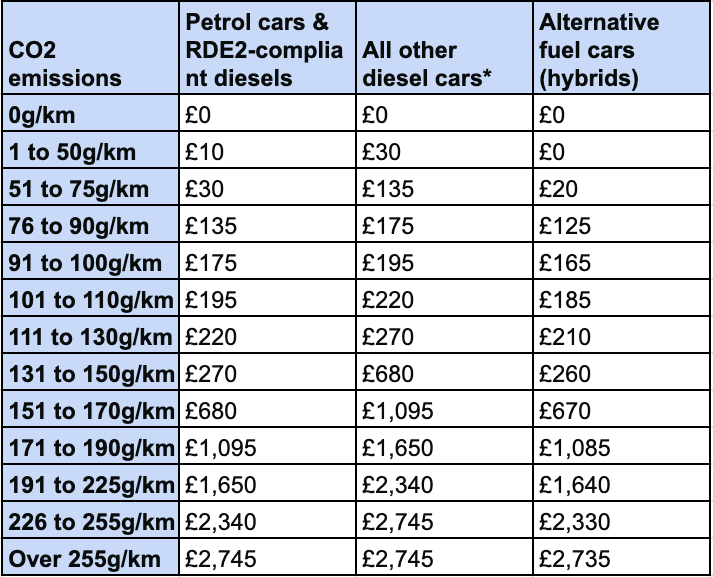
Current road-tax system: second year onwards
*For ‘alternative’ read hybrid, including plug-in and ‘mild’ hybrids – though note this £10 discount ends on 1 April 2025

Current road-tax system: cars costing £40,000 or more
This only applies for five years, from year two to year six of a +£40k car, after which tax reverts to the preceding table.

Exciting road tax tables: cars registered from 1 March 2001 to 31 March 2017
Petrol and diesel cars:
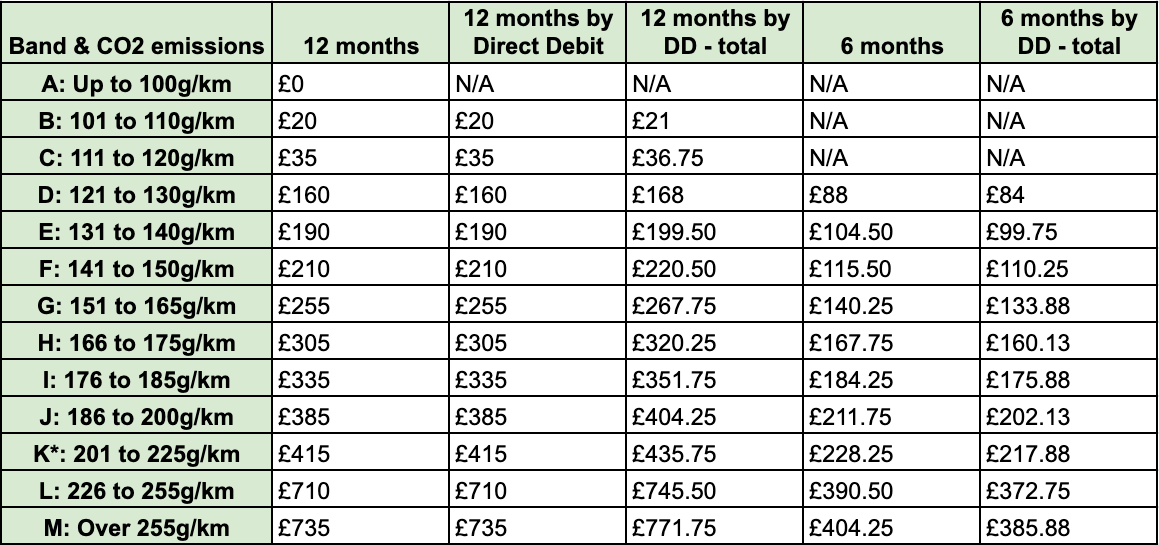
*Includes cars with CO2 figures over 225g/km but registered before 23 March 2006.
Hybrids first registered from 1/3/01 to 31/3/17
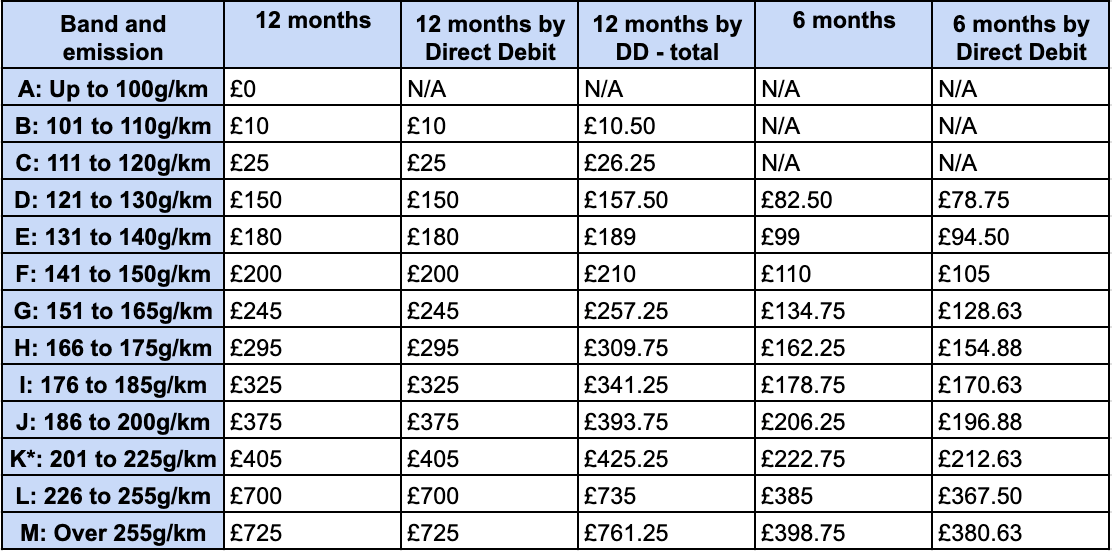
Cars registered before 1 March 2001

If you've made it this far, congratulations. As a coda, I totted up the different amounts of tax a second-hand car could attract depending on its age, price, drivetrain, fuel type and engine size: there are 33 possible rates any one vehicle could incur. How wonderfully user friendly.


